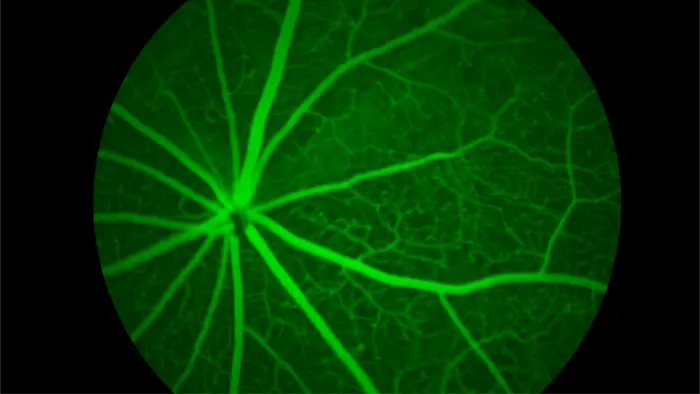
Recent advancements in our understanding of the genetic factors affecting retinal aging have unveiled a whole new dimension in the study of age-related eye diseases. Researchers at The Jackson Laboratory (JAX) have reported groundbreaking findings that highlight how genetic backgrounds significantly influence retinal health as individuals age. The implications of this work are particularly important, given the increasing prevalence of age-associated vision problems among the global population.
The study, which appears in the prestigious journal Molecular Neurodegeneration, provides insight into the age-related changes occurring in the retinal tissues of various strain mice. The research team, spearheaded by Professor Gareth Howell, explored the complex interactions between genetics and retinal aging. Howell’s remarks about the necessary diversity in study models echo a fundamental shift in how scientific investigations into aging may be conducted moving forward.
By examining nine different strains of mice, this research effectively mirrored the genetic variability found in human populations. This variety uncovered profound differences in the retinal aging process among the different strains, emphasizing that aging is not a uniform experience. Traditional studies often utilized a single strain, which limited the understanding of how genetics contribute to the aging process, particularly in an organ as intricate as the eye.
As Howell points out, aging is inherently heterogeneous—each organism experiences it differently based on its genetic makeup. Therefore, using a single, genetically uniform mouse strain may have masked the complexities associated with understanding the biological mechanisms behind sight deterioration. JAX’s decision to analyze multiple strains reflects an innovative approach that could lead to enhanced awareness of genetic predispositions to various ocular diseases.
The research findings reveal that while all tested mice showcased typical aging traits, the manifestation and impact of these traits varied significantly from one strain to another. This variance signifies the influence of distinct genetic factors, allowing researchers to better correlate these findings to human conditions. Such insights are invaluable, especially in the context of progressive conditions like diabetic retinopathy, which affect millions worldwide and can lead to irreversible vision loss.
Furthermore, the researchers found that certain mouse strains closely mirrored human retinal diseases. For instance, one strain, known as Watkins Star Line B (WSB), exhibited characteristics similar to age-related macular degeneration and retinitis pigmentosa, while another strain, New Zealand Obese (NZO), which is predisposed to obesity and diabetes, displayed features associated with diabetic retinopathy. These discoveries could pave the pathway for developing targeted therapies for these conditions.
Notably, the data obtained from genetic and protein analyses enabled predictions regarding the onset and progression of age-related eye diseases in specific mouse strains. Olivia Marola, a postdoctoral associate at JAX, expressed optimism at how these molecular insights foreshadowed detailed retinal cell abnormalities. The findings promise to enhance our knowledge of retinal functionality, particularly how genetic factors may influence the development of various ocular conditions over time.
The importance of these genetically diverse mouse models cannot be overstated. They offer opportunities not just for understanding disease progression but also for testing novel therapeutic interventions. As scientists hone in on the specific roles of certain genes in eye health, they could potentially identify new targets for pharmaceutical developments aimed at preventing or slowing the progression of debilitating eye diseases.
Interestingly, the implications of this research extend beyond ocular health into the realm of neurodegenerative diseases. The retina, being a direct extension of the central nervous system, may harbor clues to understanding diseases such as Alzheimer’s. By studying retinal aging, researchers might unearth new pathways linking aging in the eye to changes in brain health, reinforcing the idea that investigating the eye could lead to broader insights into neurological conditions.
Howell’s assertion that “the eye is a window into the brain” reflects a growing perspective in the scientific community. By correlating eye health with cognitive decline, researchers may devise screening tools that enhance early detection of Alzheimer’s and similar afflictions. As our understanding of the eye’s role in broader health contexts evolves through studies like these, it moves us closer to devising strategies that could mitigate neurodegeneration.
Moreover, with their dataset now publicly accessible, Howell and his team contribute a valuable resource that strengthens the collective endeavor of researchers investigating the multifaceted nature of aging and its associated disorders. The hope is that other scientists will leverage these findings to expand their own research agendas, potentially advancing the fields of both ophthalmology and neurology concurrently.
As we push forward into an era defined by rapid scientific advancement, understanding how genetics governs aging processes in organs such as the eye will undoubtedly shape future research trajectories. The pioneering work conducted at The Jackson Laboratory represents a significant step in comprehending the complexities of not only vision loss but also the intricate web connecting aging with cognitive health.
Subject of Research: Animals
Article Title: Genetic context modulates aging and degeneration in the murine retina
News Publication Date: 25-Jan-2025
Web References: http://dx.doi.org/10.1186/s13024-025-00800-9
References: Molecular Neurodegeneration
Image Credits: Credit: The Jackson Laboratory
Keywords: Eye diseases, Mouse strains, Omics, Genetics, Molecular biology
Tags: advancements in eye health researchage-associated vision problemsage-related eye diseases researchbreakthroughs in neurodegeneration studiesdiversity in genetic researchgenetic factors in retinal aginggenetic variability in agingimpact of genetics on brain healthimplications of retinal health geneticsmouse models in aging studiesProfessor Gareth Howell researchretinal tissue aging mechanisms





